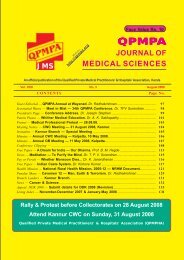QPMPA Journal September 2011 - Qualified Private Medical ...
QPMPA Journal September 2011 - Qualified Private Medical ...
QPMPA Journal September 2011 - Qualified Private Medical ...
You also want an ePaper? Increase the reach of your titles
YUMPU automatically turns print PDFs into web optimized ePapers that Google loves.
science<br />
○ ○ ○ ○ ○ ○ ○ ○ ○ ○ ○ ○ ○ ○ ○ ○ ○ ○ ○ ○ ○ ○ ○ ○ ○ ○ ○ ○ ○ ○ ○ ○ ○ ○ ○ ○ ○ ○ ○ ○ ○ ○ ○ ○ ○ ○ ○ ○ ○ ○ ○ ○ ○ ○ ○ ○ ○ ○ ○<br />
molecular biology<br />
The interface where inorganic<br />
is temporarily made organic!<br />
Molecular biology, the interface between<br />
organic and inorganic worlds,<br />
arose from convergence of genetics,<br />
physics, and chemistry on the common<br />
problem: ‘structure and function of the<br />
gene’. It is not so much a technique as<br />
an approach. It searches for the molecular<br />
plans below the large-scale<br />
manifestations of biology. Biophysics<br />
tries to study the molecules of life “from<br />
the ground up”.<br />
DNA coding of a protein is cloned. The<br />
cloned plasmid has elements to drive protein<br />
production and antibiotic resistance<br />
markers to help follow it. This can be inserted<br />
into cells; either integrated into the<br />
genome or may remain independent of<br />
the genome. In either case, the cell proteins<br />
produced by stimulation of plasmid<br />
can be studied. It can be tested for<br />
enzymatic activity and activity of drugs<br />
against it.<br />
In the early twentieth century, mechanism<br />
of gene reproduction and mutation<br />
was unknown. Thomas H. Morgan used<br />
fruit fly, Drosophila, to study the relationship<br />
between gene and chromosomes.<br />
Hermann J. Muller, recognized<br />
“gene as the basis of life,” and discovered<br />
Image of original DNA<br />
the mutagenic effect of X-rays on Drosophila.<br />
However, he recognized he was<br />
limited in the extent to which he could<br />
explicate the more fundamental properties<br />
of genes and concluded, “The geneticist<br />
is helpless to analyse the properties<br />
further.”<br />
The next decade saw several physicists<br />
turning their attention to ‘inheritance’.<br />
Erwin Schrödinger, proposed ways in<br />
which quantum physics might account<br />
dr. m. devadas<br />
for the stability, yet mutability, of gene.<br />
He speculated that the gene might be a<br />
kind of irregular “aperiodic crystal” playing<br />
a role in the “hereditary code-script.”<br />
Max Delbruck became interested in the<br />
physics of heredity after a lecture by Niels<br />
Bohr, which expounded a principle of<br />
complementarily between physics and<br />
biology. In contrast to Schrödinger, Bohr<br />
did not seek to reduce biology to physics,<br />
but to understand how each discipline<br />
complemented the other. And later<br />
Delbruck admitted even the fruit fly was<br />
too complex to unravel the enigma of life.<br />
He chose bacteriophage instead. Delbruck<br />
and another physicist-turned-biologist<br />
Salvador Luria proved genes were not proteins<br />
but DNA.<br />
Linus Pauling utilized his knowledge of<br />
structural chemistry to study macromolecular<br />
structure of cell. Pauling investigated<br />
weak forms of bonding, such<br />
as hydrogen bonding, which were later<br />
discovered to play important roles in proteins<br />
and nucleic acids. Pauling also made<br />
use of x-ray crystallography to investigate<br />
molecular structure. X-rays bombarding<br />
a molecule left unique photographic<br />
images due to diffraction. Pauling<br />
discovered the alpha-helical structure of<br />
proteins and eventually set his sights on<br />
○ ○ ○ ○ ○ ○ ○ ○ ○ ○ ○ ○ ○ ○ ○ ○ ○ ○ ○ ○ ○ ○ ○ ○ ○ ○ ○ ○ ○ ○ ○ ○ ○ ○ ○ ○ ○ ○ ○ ○ ○ ○ ○ ○ ○ ○ ○ ○ ○ ○ ○ ○ ○ ○ ○ ○ ○<br />
118<br />
<strong>QPMPA</strong>.JMS . Vol. XXV . No. 3 . June-Sept. <strong>2011</strong>



